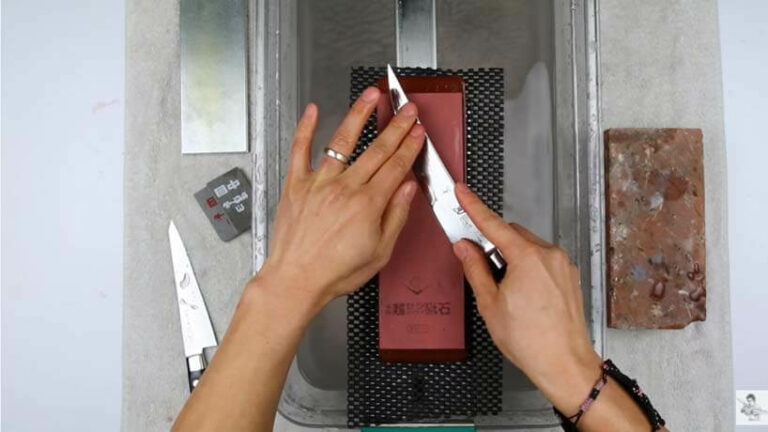If you take all of your knives out and spread them over the table, you’ll probably see a dazzling variation. However, one knife will stand out of others because of its unique edge- yes, that’s the serrated knife. Since it’s quite different from others, it’s crucial to know how to sharpen a serrated knife.
Kitchen is where you’re most likely to encounter a serrated knife, as bread knives are always serrated. They’re also quite useful for cutting and slicing fruits and vegetables with thin skin and soft innards. It’s also common to see steak knives, machetes, pocket knives, survival knives and folding knives with serrated edges. Some knives even have a bit of serration on an otherwise straight blade.
From the name “serrated knife” you can understand that this knife comes with serration or teeth along the cutting edge. Unlike smooth, simple edged knives, serrated edged knives are tough to sharpen. They cannot be sharpened using regular, end to end strokes. Sharpening a serrated knife requires much greater care, precision, and time. It needs different tools too.
Ways to Sharpen a Serrated Knife
Using a Sharpening Rod
As you are more likely to find a serrated knife in the kitchen, which is also called the bread knife, you’ll also likely find a sharpening rod in your kitchen. However, to sharpen a bread knife at home, you can’t use the rod the same way you use it to sharpen straight-edged knives.
Ceramic sharpening rods that taper off to a pointy edge are more useful to sharpen a serrated knife. Mostly because the slim edge of the rod can fit flush against each of the serrations or between the “teeth” of the blade. Make sure to set the rod on the beveled side of the serration, and not the flat side.
Once it has fit in a serration, move it in a smooth back and forth motion to achieve sharpness. Usually, it takes no more than 4-5 strokes. You have to individually sharpen each of the serrations with this rod, and this might take a while. No matter which brand and type you have, to sharpen a serrated bread knife you may have to pay attention to each of the 30 or so teeth.
After all the serrations are sharpened, you might feel there’s a burr forming on the flat side of the blade. Running this side against a sander should remove it easily. This is the easiest answer to: “how to sharpen a serrated knife”?
Using a Spyderco Sharpmaker
If you have a Sharpmaker at home, you can make use of the rods it sports to sharpen a serrated steak knife. Steak knives are usually quite expensive and sturdy, and when they get dull it’s usually a pricey affair to get them sharpened again.
Fear not! The Sharpmaker will be helpful to sharpen a serrated blade in no time, be it a steak knife or a serrated pocket knife. Just like using an individual sharpening rod, fit one of the serrations to one edge of a triangular rod in the Sharpmaker, then continue sharpening it. Then use the other rod for removing the burr. That’s simply how to sharpen a serrated knife using a Spyderco Sharpmaker.
Using an Electric Sharpener
Can you sharpen a serrated knife with an electric sharpener? The easy and quick answer is, yes, you can in fact sharpen a serrated edge knife with an electric sharpener. But I would not advise it if you want to keep using the knife for a long time. If you know how to use them, electric sharpeners do an awesome job in a short time. However, they also tend to shave quite a lot of metal off of the knife’s edge.
If you’re in a pinch and need to have your serrated knife sharpened yesterday, you can give the electric sharpener a go. Some electric sharpeners accommodate these knives, so read the instructions and stick to them. But don’t make a habit of it, as with prolonged use you’ll notice your knife will lose the serration and just turn into an ordinary knife.
Importance of Properly Sharpening a Serrated Knife

Let me tell you some good news about serrated knives: they don’t go dull for ages! The serration is what keeps the blade sharp for a long time, and even when it goes dull, it can be used to some extent. Only after it gets significantly dull is when you need to know how to sharpen a serrated knife.
Yes, the process might seem tedious but look at the bright side- after sharpening you can keep using it for another few years, at least! Some people do not know about this, and they’re so puzzled by the thought, “how do you sharpen a serrated knife?” In the end they just end up throwing the knife away.
When the knife is cheap, it’s alright. However, you should start out by buying a good quality high-carbon serrated knife. It can serve you for years and after a sharpening, it can go on for even longer.
Additional Care of Serrated Knives
I know I’ve mentioned that serrated knives don’t go dull easily, but it does happen. To make sure your serrated knife does not go dull anytime soon, doesn’t rust or develop nicks and dings, make sure to take good care of it.
Things to keep in mind:
How to Pick a Serrated Knife That Wouldn’t Dull Easily
We’ve established that sharpening a serrated knife is a daunting task. So what you should do is buy a good one that wouldn’t dull for a while. Here are the particulars you should consider when buying a serrated knife:
A handy advice: Some manufacturers offer to sharpen your knife for free. Check out serrated knives with deals like that so you wouldn’t have to worry about it later.
Conclusion
Now that you know how to sharpen a serrated knife using a variety of methods, as well as how to keep it sharp, I’m going to impart one last piece of advice. I’ve told you what kind of serrated knife you should buy. Additionally, also pay some attention to the cutting board you’d be using with this knife.
You should never use a cutting board that’s made of tougher stuff than the knife itself: that’s a sure way to ensure your serrated knife dulls fast. So, use a benign plastic, wood or bamboo cutting board. If you follow all the recommendations I’ve stated above, you can easily sharpen and keep your serrated knife sharp for a long while.







